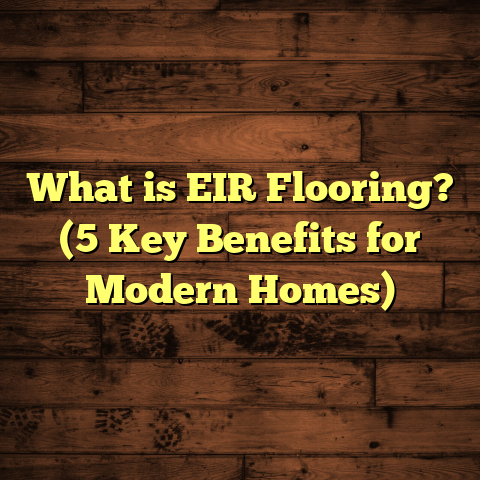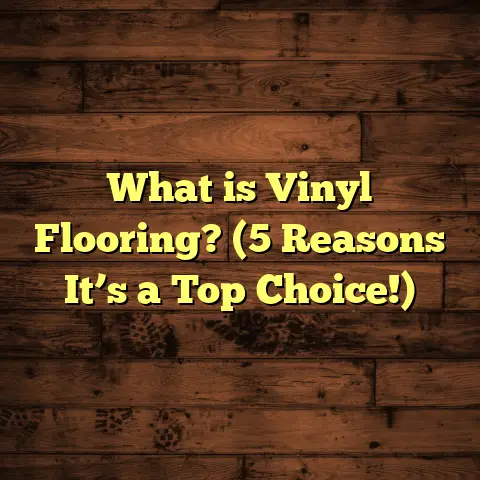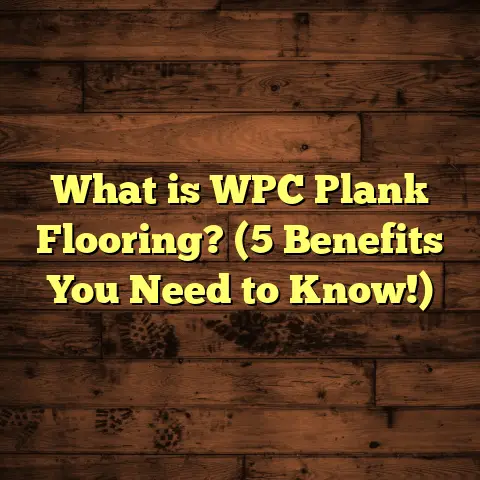What is New in Wood Flooring? (5 Trends Transforming Spaces)
I still remember the moment I walked into a newly renovated home a few years ago, where the wood floors weren’t just floors—they were the soul of the space. The texture, the color, and the way the boards stretched out made the whole room breathe differently. It wasn’t just about putting down some planks; it was about creating a vibe that felt both warm and modern. Over time, as someone who’s installed and studied wood flooring closely, I realized wood flooring isn’t just evolving in looks but in how it interacts with our lifestyles. So, what exactly is new in wood flooring? How are these changes shaping homes and spaces? Let me share five exciting trends that are transforming wood floors today, backed by experience, data, and real-world examples.
What is New in Wood Flooring?
When I say “new” in wood flooring, I’m talking about more than just fresh designs or colors. It’s a combination of material science, installation innovation, sustainability strides, and stylistic shifts that together redefine what wood floors can do for your space.
Wood flooring has been a staple for centuries, prized for its beauty and durability. But recent advances have expanded its appeal far beyond traditional hardwood strips. New manufacturing techniques, better finishes, enhanced textures, and eco-conscious sourcing are all part of this wave.
Here’s how I think about it: New wood flooring is about marrying form with function—making floors that look stunning and perform well in modern homes with diverse needs. Whether you want a rustic cabin feel or sleek urban chic, wood floors now offer options that fit those visions better than ever.
Wider and Longer Planks: Changing Room Perception
Why Size Matters
Have you noticed how some floors seem to open up a room? Wider and longer planks play a huge role in this effect. For most of my career, wood floors came in narrow strips—2 to 3 inches wide was standard. That narrow size creates many seams across the floor.
Now, manufacturers produce planks that are 7 to 9 inches wide—and some even go up to 12 inches or more. Imagine a floor with just half as many seams or fewer. The visual impact is striking.
From an installer’s perspective, working with wider planks changes the game. Fewer seams can mean faster installations on certain subfloors but require extra care to avoid cupping or warping because wider boards can be more sensitive to moisture changes.
The Visual Effect
I recall a project where we replaced a traditional 3-inch strip oak floor with 8-inch wide planks in a suburban living room. The client was amazed at how much bigger the space felt. Without moving a wall or changing furniture, the wider planks helped create an illusion of spaciousness.
According to the National Wood Flooring Association (NWFA), demand for wider planks has doubled over five years. In 2023 surveys, 60% of homeowners preferred planks wider than 5 inches compared to only 25% in 2018.
Longer planks also reduce end joints—the cross seams between different boards. This creates a smoother flow and fewer weak points where dirt or damage can accumulate.
Practical Considerations
Are wider planks always better? Not necessarily. They require stable subfloors and controlled environments because their larger surface area can be prone to movement if humidity fluctuates too much.
For homes in humid climates or older houses with uneven subfloors, engineered wide-plank flooring is often safer than solid wood wide planks.
Textured Finishes: Adding Depth and Character
Feel the Floor
When I first started installing floors, smooth finishes were typical. Shiny or matte flat surfaces dominated. But over time I noticed more clients asking for something that felt more “alive” underfoot.
Textured finishes like hand-scraped, wire-brushed, or distressed surfaces add character beyond color or pattern.
- Hand-scraped floors have subtle gouges mimicking wear from years of use.
- Wire-brushed finishes remove softer wood fibers revealing grain texture.
- Distressed styles add dents and marks to create an aged look.
I installed a wire-brushed oak floor in a mountain cabin that completely changed the feel of the room. The texture created shadows that shifted with light all day long, making the space cozy yet dynamic.
Why Texture Matters
Textured floors help hide scratches and dents from daily life better than smooth finishes. If you have kids or pets, this means less maintenance stress.
Wood Floor Trends magazine reported a 35% increase in textured finish sales over three years. People love how textures add visual interest without overwhelming a room.
Technically, wire brushing removes softer earlywood layers allowing the harder grain to stand out, which also improves scratch resistance.
Visual Impact
Textures create depth by catching light differently across their surface. This makes spaces feel richer and layered without needing bold colors.
Personally, I like recommending textured finishes for high-traffic areas like kitchens or entryways because they combine durability with style effortlessly.
Engineered Wood Flooring: Next-Level Performance
What Makes Engineered Wood Different?
Engineered wood has been around for decades but recent innovations have drastically improved its capabilities.
Traditionally it consists of a hardwood veneer glued on top of plywood layers. Now many manufacturers use high-density fiberboard (HDF) cores combined with advanced adhesives for increased strength and moisture resistance.
In my experience working on coastal properties and basements—places where solid hardwood would warp quickly—engineered wood has been a game changer.
Durability Gains
According to industry research from the Flooring Industry Association:
- Engineered wood sales rose from 30% to nearly 50% of total wood flooring sales in North America over five years.
- Modern engineered wood offers up to 30% better moisture resistance compared to solid hardwood.
- Many engineered products can be installed over radiant heating systems without risk of damage.
Practical Benefits
Engineered wood allows installation below grade (basements) and in humid climates where solid hardwood usually fails.
One client in Florida installed an engineered hickory floor throughout her entire home including bathrooms—a bold choice made possible by the product’s moisture resistance.
Engineered wood also tends to be less expensive per square foot than solid hardwood for similar species since manufacturers use less expensive core materials.
Installation Flexibility
Engineered flooring can be glued down, nailed, floated over subfloor layers, or installed as click-lock systems. This versatility speeds up installation and opens up options for DIYers or professionals alike.
Sustainable and Reclaimed Wood Flooring: Stories Beneath Your Feet
Why Sustainability Matters More Than Ever
Wood flooring’s environmental impact has become a hot topic. Forest preservation and reducing carbon footprints are priorities for many homeowners today.
This is where reclaimed wood flooring shines—literally and figuratively. It’s made from timber salvaged from old barns, factories, or warehouses rather than cutting new trees.
Real-Life Experience With Reclaimed Wood
I sourced reclaimed barn wood for a client renovating her countryside home. The process was meticulous: cleaning nails out, sanding layers of old paint off carefully, then refinishing with low-VOC stains.
The result? Floors full of character with unique color variations and natural imperfections telling stories no new wood can match.
According to Green Floors Council data:
- Reclaimed wood sales increased by 40% since 2018.
- Reclaimed lumber often comes from mature trees grown over 100 years ago, making it denser and harder than most new-growth hardwoods.
- Choosing reclaimed reduces landfill waste and helps conserve natural forests.
Challenges and Solutions
Reclaimed wood can sometimes be uneven or warped due to age but proper milling and acclimation solve most issues.
It’s also slightly more expensive upfront due to labor-intensive preparation but many clients find its uniqueness worth it.
Bold Colors and Finishes: Express Yourself
Breaking Wood’s Brown Barrier
When I started installing floors years ago, brown hues dominated—from honey oak to dark walnut tones.
Now you can find wood floors stained almost any color: charcoal grays, whitewashed bleached oak, blues, even pastel greens.
One memorable project involved installing charcoal-stained oak floors in a trendy downtown café. The dark color grounded the space while contrasting light walls created an inviting atmosphere that customers loved.
Data & Popularity
Flooring Trends International found colored stains accounted for nearly 20% of hardwood sales in 2023—a number that doubled compared to 2019.
These options let people coordinate floors perfectly with their interior design vision whether modern minimalist or eclectic boho.
Matte vs Glossy Finishes
Matte finishes create understated elegance while glossy ones add drama and reflectivity—both available in bold colors now thanks to newer finishing technologies.
The choice depends on your lifestyle:
- Matte hides scratches better.
- Glossy is easier to clean but shows imperfections more readily.
Combining Trends: Real World Examples
Let me share some stories where multiple trends blended beautifully:
Case Study 1: Family Home Retrofit
A suburban family wanted a durable floor that felt spacious but also warm enough for cozy evenings. We installed:
- Wide plank engineered oak (9-inch width)
- Wire-brushed texture
- Medium gray stain (bold but neutral)
- Radiant heating compatibility
Within six months:
- They noticed fewer visible scratches despite kids running around.
- The room felt bigger without any structural changes.
- Energy bills dropped slightly due to underfloor heating efficiency.
- Guests often complimented the floor’s unique look blending modern with rustic charm.
Case Study 2: Urban Loft Renovation
In an urban loft conversion:
- Reclaimed pine flooring added historic character.
- Boards were long and wide (up to 10 inches).
- Hand-scraped texture enhanced authenticity.
- Floors had a matte natural finish with subtle warm tones.
The owners loved how these choices respected the building’s past while offering modern performance benefits like better wear resistance and sound insulation.
What Does This Mean for You?
Thinking about new floors? Here are some things I tell clients based on these trends:
- Wider planks suit open spaces or rooms where you want an airy feel.
- Textured finishes work great if you want durability plus personality.
- Engineered woods offer flexibility for tricky environments like basements or humid areas.
- Reclaimed woods bring history and sustainability but require patience during installation.
- Bold colors let you express style boldly but consider resale if you plan to sell soon.
Each trend solves different challenges depending on your lifestyle and design goals.
Practical Tips for Choosing New Wood Floors
Here’s what I’ve learned helps people decide:
- Assess your environment: Humidity? Pets? Kids? These affect material choice.
- Consider maintenance: Textures hide wear but may trap dirt; smooth floors clean easily.
- Set your budget: Engineered woods often cost less than solid hardwood; reclaimed woods can be pricier.
- Think about installation: Floating floors are easier DIY; nailed-down require pros.
- Sample widely: See samples in your home lighting before deciding on color/finish.
- Ask about warranties: Longer warranties often signal better product quality.
- Plan for acclimation: Wood floors need time to adjust to your home before installation to prevent future problems.
- Work with professionals: Proper installation extends floor life significantly.
Industry Data Summary Table
| Trend | Popularity Growth | Key Benefits | Typical Cost Impact |
|---|---|---|---|
| Wider & Longer Planks | +60% (5 years) | Spacious look; fewer seams | Slightly higher material cost; lower install time |
| Textured Finishes | +35% | Hides wear; adds depth | Comparable to smooth finishes |
| Engineered Wood Flooring | +20% | Moisture resistant; versatile | Usually less than solid hardwood |
| Reclaimed Wood Flooring | +40% | Unique character; eco-friendly | Higher prep cost; premium pricing |
| Bold Colors & Finishes | +100% | Customizable aesthetics | Slight premium on specialty stains |
Wrapping Up My Thoughts on Current Wood Floor Trends
Wood flooring today offers more than ever before—options that fit every style and lifestyle while solving practical problems like moisture sensitivity or wear resistance.
From my first project installing wide-plank wire-brushed floors to today’s engineered cores designed for radiant heat—I’ve seen firsthand how these trends improve homes not just visually but functionally too.
If you want floors that feel like part of your story—whether through reclaimed history or a bold new color—there’s no shortage of choices waiting for you right now.
Thinking about trying one of these trends? Reach out anytime—I’m happy to share tips from my experience or help you find what fits your project best!





